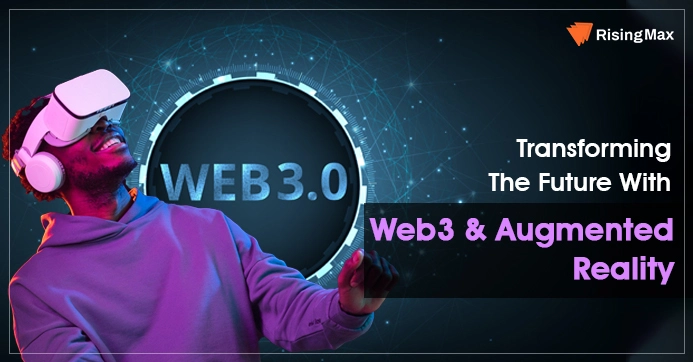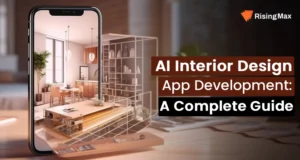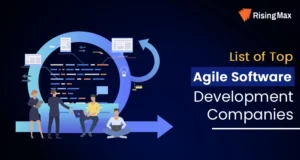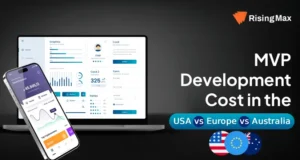We hear much about virtual reality when discussing the metaverse and Web3 (VR). Augmented reality (AR) is barely discussed casually, and thus both are often confused as closely related among non-technical viewers.

More importantly, the distinct differences between the two technological innovations have consequences for the metaverse’s future.
AR is an amalgamation of digital innovation and the user’s physical environment. Conversely, VR provides people with a purely arbitrary 3D environment with which they can engage through special equipment such as VR headsets. In short, AR users have a fully immersive mixed-media experience with digital information superimposed on top of their real-world surroundings.
If you want to use AR-powered innovations to manage your Web3 operations more efficiently, contact our experts at RisingMax Inc. Our Web3 developer team uses their expertise to build Augmented Reality Web3 applications that meet the needs of your business. Contact our Web3 developers to discuss your project requirements. HURRY UP!What Is Web3 Or Decentralized Web?
Web 3.0 is a premise for the internet’s upcoming era. It is advancing user control and ownership over their creative works, online content, digital assets, and online affiliations.
Web 2.0 is the phenomenon we are currently witnessing. Organizations build and provide goods and services with proper centralization. For instance, consider Instagram.
Do you believe you own your Instagram content? No, the corporation holds the entire platform and authority over all the information users create. They will forbid or restrict you if they so desire.
However, with the adoption of blockchain and cryptocurrencies in Web 3.0, users create information while possessing, controlling, and realizing it. This is what makes NFTs possible. You’ve certainly been aware of it.
Users can communicate with internet platforms controlled by peer-to-peer networks, primarily a decentralized computer-to-computer network rather than a single entity’s server.
In such a configuration, users own their data and conduct permissionless and peer-to-peer transactions, eliminating the need for middlemen and allowing anyone with an internet connection and cryptocurrency wallets like Metamask to participate.
Let’s see some of the alluring features of the decentralized web (Web3).
Decentralization
Decentralization is a key component of Web 3.0, allowing end users to acquire full data control. This is facilitated by Web3 development companies that create Web3 solutions based on decentralized peer-to-peer blockchain networks. As a result, in Web3, there is no unique point of failure or regulation.
Permissionless And Trustless
Users can communicate with one another through trustless networks without the necessity of a trusted intermediary. Permissionless networks, in essence, allow users to establish connections to the network without the intervention of any governance bodies. Trustless and permissionless networks enable decentralization in Web 3.0.
Actual Browsing Experience
Web 2.0 revolves around providing users with a two-dimensional experience. Web 3.0, on the other hand, integrates innovative tech such as 3D graphics and AR/VR to provide realistic internet surfing perspectives. This is equivalent to Web3 metaverse advancement, which aims to blend the boundaries between physical and virtual worlds.
AI and machine learning
Web 2.0 focused solely on “The Social Web,” while Web 1.0 was about “The Hypertext Web.” Web 3.0, on the other hand, will procedure all user details using “Semantic Web” and NLP (Natural Language Processing) methods. The Semantic Web, in essence, establishes a standard for applications, businesses, and communities to exchange information. All of this data exchange is made possible by software powered by AI and ML algorithms.
Augmented Reality and Web3
AR, much like metaverse, is expected to be a crucial aspect of Web3, but it needs to reflect Web3 as a whole. AR has been a component of the wider digital discussion for several years. However, in recent times, it emerged as a configurable intermediate capable of generating a higher return for both consumers and companies.
With the emergence of WebAR and the incorporation of native AR functionality in the greater part of smartphones, involvement in using 3D and AR for reasons other than gaming has increased massively, with apps such as 3D layout and AR facilitating purchasing rapidly becoming preferences for marketing firms across product business units.
This increasing usage of 3D and AR is advantageous for Web3 since more consumers have become accustomed to extracting benefits from engaging content driven by engaging graphics.
While 3D and augmented reality do not entail Web3 applications in and of themselves, they are establishing the foundation and instructing users for the time when we eventually reach Web3.
Web AR is entirely performed inside the web browser, meaning no app installation is necessary to perceive the augmented information. WebAR perceptions can include a wide range of content and features.
Web AR lowers the user’s entry barrier by eliminating the need to install an app to envision the AR content. Rather, every Web AR experience has its URL and an integrated camera feature.
The person navigates to the custom Domain in their browser window and taps to enable camera access to activate the Web AR experience. This implies that Web-based AR perspectives can be triggered by QR codes, which also have gone mainstream in our increasingly contactless community. Web AR innovations include various media formats, such as conventional photos, 2D video, 360 video, and visual effects.
Thinking about the future with Web3 has the possibility of altering that. Augmented reality technology is quickly updating as a key aspect in the technology and retail sectors, and it is helping to bring 3D user experiences to the Internet.
AR is a digitally altered event of the real tangible world attained with the help of digital visual stimulation delivered via technology. It is a rising trend among all of the firms operating in mobile computing and software products; however, it is also used on numerous other platforms, such as social media.
Augmented reality allows consumers with a true 3D perception via innovative functionality such as:
- Modeling in Three Dimensions
- True-to-Size/Plane Tracking
- Face Scanning
- Target Marketing
Now that you’ve mastered the concepts of Web 3.0 and Augmented Reality let’s look at how these two technologies assist one another.

AR’s future is open and decentralized.
Only those applications that allow users to control their data and assets will thrive in the future. Users are aware from prior experiences that companies such as Facebook are poor stewards of user data and interests. They may be reluctant to trust a centralized Metaverse and thus seek a Web 3.0-powered metaverse.
Best Metaverse Development Company
Open-source and interoperable
At the moment, Metaverses function as walled gardens. The creator economy is suffering due to the Metaverse’s lack of interconnections and interoperability, which is why Web 3.0 comes into play. Because Web 3.0 employs the Semantic Web, driven by blockchain, AI, and ML, it allows connectivity between augmented reality to be data protection, fully decentralized, and anonymous.
Tangible Benefits Of Augmented Reality For Businesses
The promise of an eternal virtual reality world experience incorporating various vertical markets and cutting-edge innovation will undoubtedly provide better quality and essential advantages for your digital world online platform.
- Transforming any type of enterprise by simulating reality in the virtual space.
- Significantly increase the enterprise adornment
- Improve your consumers’ experiences and their interactions.
- Web3 gives your digital world business double its strength.
- Augmented Reality gaming platform provides the best consumer experience in the virtual space.
Fundamental Features For Web3 AR Experiences
Six Degrees of Freedom (6DoF)
To locate a digital version in a real-world situation, Web3 AR necessitates six degrees of freedom. This implies that WebAR must be able to monitor a model’s three axes of perception and three axes of position to control a 3D image.
Camera Stream
Camera Stream Web3 AR innovation synchronizes the simulated and real worlds through camera stream access. An RGB camera is required to provide a point of view and field of vision to augment a local world with an AR experience.
Scene Understanding
To locate a three-dimensional object in a spatial context, WebAR needs scene understanding. This refers to the potential of a mobile device to track a surface and evaluate the adjacent light in the surroundings.
Cloud CMS
Eventually, Web3 AR is finalized with a cloud-based CMS (content management system) that allows users to interact with an AR experience via various triggers.
These factors are typically QR codes but can also be links, markers, or the person’s face. Immersive information can be ingrained anywhere by allowing individuals to access webAR with a simple lens acquisition.
WebAR Frameworks
AR.js
The AR.js framework helps open-source AR that is free, cross-platform, and does not require configuration on any technologically advanced device.
ARToolKit
JSARToolKit, centered on the free and open-source ARToolKit monitoring library, renders 3D objects over physical reality using WebGL and Three.js.
Argon.js
The argon.js framework offers a variety of abstract concepts and utility services for incorporating an AR view into your web-based application in a platform- and tech manner, whether included in building a new AR application or integrating an AR view into an existing online application.
Awe.js
Other Immersive environments provided by Awe.js include augmented reality markers, location-based, and leap motion sensing AR. It creates an Augmented reality application in the search engine using WebRTC, WebGL, and the getUserMedia device API.
Three.ar.js
Three.ar.js is a three.js assistant framework for creating AR web perspectives in WebARonARKit and WebARonARCore. WebARonARKit and WebARonARCore are iOS and Android innovative applications that enable developers to create Augmented Reality (AR) perceptions using web applications.
X3DOM
X3DOM is a fully accessible framework and dynamic allocation for Web-based 3D graphics. It aims to meet the prevailing HTML5 configuration for descriptive 3D content and permits X3D components to be included in any HTML5 DOM tree.
Vuforia
Vuforia is a compelling and robust app-based development methodology. It has innovative object-tracking AR technology, which enables more consistency when trying to place virtual elements in a physical environment. It also offers the ability to instantly view designs from various points of view by using the “Model Target” functionality.

Why Should You Choose RisingMax Inc.?
RisingMax Inc. has the honor of collaborating with clients worldwide to develop breakthrough business solutions. After working in cutting-edge technologies such as blockchain, AI, and the metaverse, we have learned the art of Web3 development. Our team’s comprehensive expertise and innovation skills are used to develop minimal-cost Web3 AR portals for our clients.
When you work with us, you will receive the following benefits:
- Web3 development and consulting services
- Inexpensive Web3 Augmented Reality Platforms
- Technology Expertise
- Qualified Web3 developers
- Scalable IT solutions
- Clear Pricing
- Customer Oriented
- Agile Development
- Onsite-Offshore Model
- Customer service is available 24/7
The Future Is Here!
The ideas of Augmented Reality and Web3 are sweeping the world, with captains of industry hailing them as the technology of tomorrow. The sector is expanding, although we are still in the early stages of a long journey involving Blockchain, VR, and the Metaverse.
With increasing industry involvement and innovative approach within reality, one can reliably know the good prospect of new-age technologies.
Augmented Metaverse will soon enhance its market dominance by fully replacing conventional frameworks, tools, and facilities. Whatever takes place next within the AR and Web3 spaces, we can expect game-changing advancements and technologies for the worldwide population.
Metaverse Consulting Services in NYC
Interested in Learning More? Inquire about RisingMax's solutions, consulting, or any other services you can think of. We are eager to assist.










